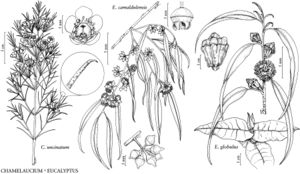Eucalyptus camaldulensis
Cat. Horti Camald. ed. 2, 20. 1832. name conserved
Trees, to 25 m; trunk gray or tan, nearly straight, ± smooth; bark usually shed in irregular strips distally, sometimes persistent toward trunk base; branches often hanging in clusters. Leaves (juvenile alternate, petiolate); petiole 0.3–2 cm; blade green, lanceolate, 6–20 × 1.5–2.5 cm. Peduncles 0.8–1.2 cm. Inflorescences 7-flowered, umbels. Flowers: hypanthium hemispheric, 2–3 mm, length ± equaling calyptra; calyptra mostly hemispheric, often rostrate, rarely bluntly conic; stamens white. Capsules hemispheric, 5–9 mm, not glaucous; valves 3–5, exserted. 2n = 22.
Phenology: Flowering spring–early summer.
Habitat: Disturbed habitats, river bottoms.
Elevation: 0–1200 m.
Distribution
Introduced; Ariz., Calif., Australia, introduced also in South America.
Discussion
Eucalyptus camaldulensis is the most widely cultivated eucalypt, with E. globulus and E. grandis being close second and third. Several infraspecific taxa have been recognized for this variable species and more than one of these may be naturalized in North America.
Selected References
None.
